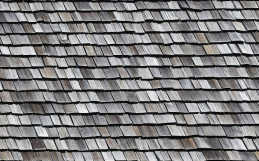(Updated June 30, 2022)
Driving around any neighborhood and you’ll see them: little square objects lining the top of the roof line on most houses. Those are roof vents and they are an important component in keeping your home comfortable. Along with eave vents, roof vents provide air circulation and ventilation for your attic.
In the summer, the attic can get incredibly warm. Think of sitting in your car with the windows rolled up on a sunny August afternoon–pretty uncomfortable, right? That also applies to an unventilated attic. Without those vents, that hot air can get transferred to the rest of the house, making your air conditioner work harder.
But these vents can also help during the winter. If the attic floor is properly insulated and sealed from below, a vented attic can keep the temperature consistent with the outside. That means snow on the roof won’t constantly melt, refreeze, and cause damaging ice dams.
Attic Ventilation Fans Pros and Cons
If your home wasn’t properly outfitted with roof vents, you may be considering a roof-mounted attic fan to expel the heat from the attic. These fans can be installed through the roof or near the peak of the roof on the back side of the home. Some are even solar-powered, requiring no wiring at all.
During the winter, these fans can also remove moisture from the air circulating in the attic. Any kind of moisture can be bad for the attic, causing mildew, mold growth, and other unhealthy conditions. These fans also prevent ice dams by keeping the attic temperatures consistent with the outside.
While attic fans provide the same kind of ventilation as roof vents, there are a few downsides. If a solar-powered fan won’t work for your location, you’ll need to hard wire one in. Also, if the house is “leaky,” the fan could actively be pulling warm air from the home or other areas of the roof.
This defeats the purpose of having consistent ventilation from the outside. If the fan is hardwired and gets too much use, there may be no net savings in the energy bill. Some of the money saved by assisting the HVAC system will go towards the fan, affecting the energy efficiency of the home.
Roof Mounted Attic Fans
While many residential homes use attic ventilation fans on the roof gable of the home, there are roof-mounted attic fan options as well. And while we don’t usually recommend adding more interruptions to your roofing system, roof-mounted attic fans can be a good idea in certain circumstances.
Is one better than the other? It depends on the situation. Since heat rises, it would seem to make sense that placing a fan near the top of the roof would help expel all of the hot air. But you don’t necessarily want to remove all of the hot air–the main purpose of an attic fan is to keep the air circulating.
To a point. Even more important than deciding between a gable and a roof-mounted attic fan is the amount of power the fans have. Where vents provide passive ventilation, fans actively move the air around. If the fans are too powerful, they may be drawing air from the rest of the home, too.
You certainly don’t want to be sucking cool conditioned air from the living area of the home out through the roof! So when looking for an attic fan, make sure you have an understanding of how much space you need to ventilate. Fans are designed to ventilate certain sizes so you should be able to get an appropriate fan.
Roof Mounted Attic Fan Options
Solar Powered: These fans run on the power of the sun, obviously. There are also solar-powered gable fans, but because they don’t get as much sunlight as the roof, they won’t be as effective.
Wind-Driven Fans: These fans are a familiar site atop commercial buildings. They are silver, spherical fans, driven by turbines that catch the wind to operate. This makes them the most energy-efficient, but when there’s no wind, they really don’t provide much ventilation.
Electrical: These roof fans require you to flip a switch when more ventilation is needed. On the one hand, they’re only used when you need them. But they will need to be wired in, which can be an extra cost and may be beyond the skills of most homeowners when it comes to installation.
Other Attic Considerations
The roof and the attic can work in concert to make your home more comfortable and even save you money. The answer depends on how you use your attic – is it a place for storage, a living area, or just a mystical place that no one ever goes?
There are a few ways you can control just how much of that heat seeps into your home or how much of the cool air escapes from it. If the attic is nothing more than a crawl space with exposed rafters, make sure there is the appropriate R-value attic insulation in place.
That alone can go a long way in keeping your home comfortable. Aside from making sure the eave or soffit vents aren’t blocked by the insulation, the use of vents or attic fans isn’t changed. The air is free to circulate, coming in through the eaves and leaving via the vents.
If the attic is conditioned and used as a living space, make sure the ceiling is properly insulated. There are a few ways to do this, either with roll-out insulation or spray foam insulation. Check with an expert to make sure the attic is up to code. You may not need venting at all.
With newer homes, codes demand a certain amount of roof vents as part of the construction process. And while adding a solar-powered or hardwired attic fan may provide some added relief, they may also work against the existing roof fans by drawing in outside air from the top of the roof, not at the eaves. That is why they need to be properly spaced, so they don’t pull from the upper vents.
In the end, the proper amount of roof vents should be enough to provide the correct amount of attic ventilation. Does your roof allow for enough ventilation? In addition to roof repair and installation, we can also inspect your roof to decide if more ventilation is needed. Give us a call to set up an inspection or for a free estimate on adding a fan.







